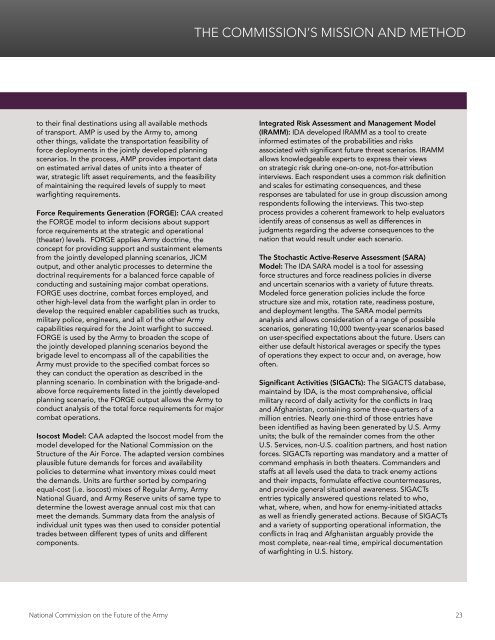THE FUTURE OF THE ARMY
Futurearmy
Futurearmy
You also want an ePaper? Increase the reach of your titles
YUMPU automatically turns print PDFs into web optimized ePapers that Google loves.
<strong>THE</strong> COMMISSION’S MISSION AND METHOD<br />
to their final destinations using all available methods<br />
of transport. AMP is used by the Army to, among<br />
other things, validate the transportation feasibility of<br />
force deployments in the jointly developed planning<br />
scenarios. In the process, AMP provides important data<br />
on estimated arrival dates of units into a theater of<br />
war, strategic lift asset requirements, and the feasibility<br />
of maintaining the required levels of supply to meet<br />
warfighting requirements.<br />
Force Requirements Generation (FORGE): CAA created<br />
the FORGE model to inform decisions about support<br />
force requirements at the strategic and operational<br />
(theater) levels. FORGE applies Army doctrine, the<br />
concept for providing support and sustainment elements<br />
from the jointly developed planning scenarios, JICM<br />
output, and other analytic processes to determine the<br />
doctrinal requirements for a balanced force capable of<br />
conducting and sustaining major combat operations.<br />
FORGE uses doctrine, combat forces employed, and<br />
other high-level data from the warfight plan in order to<br />
develop the required enabler capabilities such as trucks,<br />
military police, engineers, and all of the other Army<br />
capabilities required for the Joint warfight to succeed.<br />
FORGE is used by the Army to broaden the scope of<br />
the jointly developed planning scenarios beyond the<br />
brigade level to encompass all of the capabilities the<br />
Army must provide to the specified combat forces so<br />
they can conduct the operation as described in the<br />
planning scenario. In combination with the brigade-andabove<br />
force requirements listed in the jointly developed<br />
planning scenario, the FORGE output allows the Army to<br />
conduct analysis of the total force requirements for major<br />
combat operations.<br />
Isocost Model: CAA adapted the Isocost model from the<br />
model developed for the National Commission on the<br />
Structure of the Air Force. The adapted version combines<br />
plausible future demands for forces and availability<br />
policies to determine what inventory mixes could meet<br />
the demands. Units are further sorted by comparing<br />
equal-cost (i.e. isocost) mixes of Regular Army, Army<br />
National Guard, and Army Reserve units of same type to<br />
determine the lowest average annual cost mix that can<br />
meet the demands. Summary data from the analysis of<br />
individual unit types was then used to consider potential<br />
trades between different types of units and different<br />
components.<br />
Integrated Risk Assessment and Management Model<br />
(IRAMM): IDA developed IRAMM as a tool to create<br />
informed estimates of the probabilities and risks<br />
associated with significant future threat scenarios. IRAMM<br />
allows knowledgeable experts to express their views<br />
on strategic risk during one-on-one, not-for-attribution<br />
interviews. Each respondent uses a common risk definition<br />
and scales for estimating consequences, and these<br />
responses are tabulated for use in group discussion among<br />
respondents following the interviews. This two-step<br />
process provides a coherent framework to help evaluators<br />
identify areas of consensus as well as differences in<br />
judgments regarding the adverse consequences to the<br />
nation that would result under each scenario.<br />
The Stochastic Active-Reserve Assessment (SARA)<br />
Model: The IDA SARA model is a tool for assessing<br />
force structures and force readiness policies in diverse<br />
and uncertain scenarios with a variety of future threats.<br />
Modeled force generation policies include the force<br />
structure size and mix, rotation rate, readiness posture,<br />
and deployment lengths. The SARA model permits<br />
analysis and allows consideration of a range of possible<br />
scenarios, generating 10,000 twenty-year scenarios based<br />
on user-specified expectations about the future. Users can<br />
either use default historical averages or specify the types<br />
of operations they expect to occur and, on average, how<br />
often.<br />
Significant Activities (SIGACTs): The SIGACTS database,<br />
maintaind by IDA, is the most comprehensive, official<br />
military record of daily activity for the conflicts in Iraq<br />
and Afghanistan, containing some three-quarters of a<br />
million entries. Nearly one-third of those entries have<br />
been identified as having been generated by U.S. Army<br />
units; the bulk of the remainder comes from the other<br />
U.S. Services, non-U.S. coalition partners, and host nation<br />
forces. SIGACTs reporting was mandatory and a matter of<br />
command emphasis in both theaters. Commanders and<br />
staffs at all levels used the data to track enemy actions<br />
and their impacts, formulate effective countermeasures,<br />
and provide general situational awareness. SIGACTs<br />
entries typically answered questions related to who,<br />
what, where, when, and how for enemy-initiated attacks<br />
as well as friendly generated actions. Because of SIGACTs<br />
and a variety of supporting operational information, the<br />
conflicts in Iraq and Afghanistan arguably provide the<br />
most complete, near-real time, empirical documentation<br />
of warfighting in U.S. history.<br />
National Commission on the Future of the Army 23


